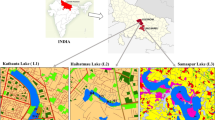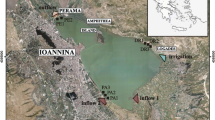Abstract
A southern Italian area that is characterized by large outcrops of rocks that are rich in titanium oxide (TiO2) phases were investigated to determine the mineralogical risk induced by the natural dispersion of TiO2 minerals. Rock, sediment and surface water samples were collected to determine the physicochemical and mineralogical factors (i.e., size distribution, morphology and alteration) indicative of potential TiO2 toxicity. X-ray diffraction data suggested that titanium oxides were present as rutile and anatase. Scanning electron microscopy images showed elongated TiO2 morphologies; fibres were found as either isolated or embedded/enclosed in flake-like phyllosilicates. The concentration of fibres in stream water ranged from 1.7 to 4.6 million fibres per litre. The highest fibre amounts in the sediments were in the <8-µm fraction, while single fibres were primarily concentrated in the <2-µm fraction. The results indicate that titanium oxide minerals represent a natural source of environmental risk and that the geomineralogical characterization of rich TiO2 areas is indispensable for understanding their geoavailability, dispersion and distribution.









Similar content being viewed by others

References
Alló, W. (2004). Authigenic Ti-bearing crystals in a Precambrian clay from Buenos Aires Province, Argentina. Clays and Clay Minerals, 52, 304–310.
Cavalcante, F., Belviso, C., Finizio, F., Lettino A., & Fiore S. (2009). Carta geologica delle Unità Liguridi dell’area del Pollino (Basilicata): Nuovi dati geologici, mineralogici e petrografici. S. Fiore ed., Digilabs, Bari, pp. 36.
Cavalcante, F., Belviso, C., Laurita, S., & Prosser, G. (2012). P-T constraints from phyllosilicates of the Liguride Complex of the Pollino area (Southern Apennines, Italy): geological inferences. Ofioliti, 37(2), 65–75. doi:10.4454/ofioliti.v37i2.406.
Crane, M., Handy, R. D., Garrod, J., & Owen, R. (2008). Ecotoxicity test methods and environmental hazard assessment for engineered nanoparticles. Ecotoxicology, 17, 421–437.
Cui, Y. L., Gong, X. L., Duan, Y. M., Li, N., Hu, R. P., Liu, H. T., et al. (2010). Hepatocyte apoptosis and its molecular mechanisms in mice caused by titanium dioxide nanoparticles. Journal of Hazardous Materials, 183, 874–880. doi:10.1016/j.jhazmat.2010.07.109.
Cui, Y. L., Liu, H. T., Ze, Y. G., Zhang, Z. L., Hu, Y. Y., Cheng, Z., et al. (2012). Gene expression in liver injury caused by long-term exposure to titanium dioxide nanoparticles in mice. Toxicology Science, 128, 171–185. doi:10.1093/toxsci/kfs153.
Fujishima, A., Hashimoto, K., & Watanabe, T. (2005). TiO2 photocatalysis: a historical overview and future prospects. Japanese Journal of Applied Physics, 44, 8269–8285.
Gillette, D. A., & Walker, T. R. (1977). Characteristics of airborne particles produced by wind erosion of sandy soil, high plains of West Texas. Soil Science, 123, 97–110.
Grey, I. E., & Reid, A. F. (1975). The structure of pseudorutile and its role in the natural alteration of ilmenite. American Mineralogist, 60, 898–906.
Gurr, J. R., Wang, A. S., Chen, C. H., & Jan, K. Y. (2005). Ultrafine titanium dioxide particles in the absence of photoactivation can induce oxidative damage to human bronchial epithelial cells. Toxicology, 213, 66–73.
Husain, M., Saber, A. T., Guo, C., Jacobsen, N. R., Jensen, K. A., Yauk, C. L., et al. (2013). Pulmonary instillation of low doses of titanium dioxide nanoparticles in mice leads to particle retention and gene expression changes in the absence of inflammation. Toxicology and Applied Pharmacology, 269, 250–262.
Hussain, S., Vanoirbeek, J. A. J., Luyts, K., De Vooght, V., Verbeken, E., Thomassen, L. C. J., et al. (2011). Lung exposure to nanoparticles modulates an asthmatic response in a mouse model. European Respiratory Journal, 37, 299–309.
IARC (International Agency for Research on Cancer), 2010. IARC Monographs on the evaluation of carcinogenic risks to humans, V. 93, Carbon Black, Titanium Dioxide, and Talc. http://monographs.iarc.fr/ENG/Monographs/vol93/mono93-7.pdf (Accessed January 12, 2015).
Iavicoli, I., Leso, V., Fontana, L., & Bergamaschi, A. (2011). Toxicological effects of titanium dioxide nanoparticles: A review of in vitro mammalian studies. European Review for Medical and Pharmacological Sciences, 15, 481–508.
Jaeger, A., Weiss, D. G., Jonas, L., & Kriehuber, R. (2012). Oxidative stress-induced cytotoxic and genotoxic effects of nano-sized titanium dioxide particles in human HaCaT keratinocytes. Toxicology, 296, 27–36.
Knott, S. D. (1987). The Liguride Complex of Southern Italy—a Cretaceous to Paleogene accretionary wedge. Tectonophysics, 142, 217–243.
Knott, S. D. (1994). Structure, kinematics and metamorphism in the Liguride Complex, southern Apennines, Italy. Journal of Structural Geology, 16, 1107–1120.
Kobayashi, N., Naya, M., Endoh, S., Maru, J., Yamamoto, K., & Nakanishi, J. (2009). Comparative pulmonary toxicity study of nano-TiO2 particles of different sizes and agglomerations in rats: Different short- and long-term post-instillation results. Toxicology, 264, 110–118.
Liu, R., Yin, L., Pu, Y., Liang, G., Zhang, J., Su, Y., et al. (2009). Pulmonary toxicity induced by three forms of titanium dioxide nanoparticles via intra-tracheal instillation in rats. Progress in Natural Science, 19, 573–579.
Lomer, M. C., Thompson, R. P., & Powell, J. J. (2002). Fine and ultrafine particles of the diet: Influence on the mucosal immune response association with Crohn’s disease. Proceedings of the Nutrition Society, 611, 123–130.
Meena, R., Rani, M., Pal, R., & Rajamani, P. (2012). Nano-TiO2-induced apoptosis by oxidative stress-mediated DNA damage and activation of p53 in human embryonic kidney cells. Applied Biochemistry and Biotechnology, 167, 791–808.
Miller, R. L., Cakmur, R. V., Perlwitz, J., Geogdzhayev, I. V., Ginoux, P., Koch, D., et al. (2006). Mineral dust aerosols in the NASA Goddard Institute for Space Sciences ModelE atmospheric general circulation model. Journal of Geophysical Research, 111, 1–19.
Morad, S. (1986). SEM study of authigenic rutile, anatase and brookite in Proterozoic sandstones from Sweden. Sedimentary Geology, 46, 77–89.
Nagelschmidt, G., Donnelly, H. F., & Morcom, A. J. (1949). On the occurrence of anatase in sedimentary kaolin. Mineralogical Magazine, 28, 492–495.
Navarro, E., Baun, A., Behra, R., Hartmann, N. B., Filser, J., Miao, A. J., et al. (2008). Environmental behavior and ecotoxicity of engineered nanoparticles to algae, plants, and fungi. Ecotoxicology, 17, 372–386.
NIOSH. (2011). Current intelligence bulletin 63. Occupational exposure to titanium dioxide. Cincinnati, OH: U.S. Department of Health and Human Services, Public Health Service, Centers for Disease Control and Prevention, National Institute for Occupational Safety. http://www.cdc.gov/niosh/docs/2011-160/pdfs/2011-160.pdf (Accessed January 12, 2015).
Ophus, E. M., Rode, L., Gylseth, B., Nicholson, D. G., & Saeed, K. (1979). Analysis of titanium pigments in human lung tissue. Scandinavian Journal of Work, Environment & Health, 53, 290–296.
Petković, J., Zegura, B., Stevanović, M., Drnovšek, N., Uskoković, D., Novak, S., et al. (2011). DNA damage and alterations in expression of DNA-damage-responsive genes induced by TiO2 nanoparticles in human hepatoma HepG2 cells. Nanotoxicology, 5, 341–353. doi:10.3109/17435390.2010.507316.
Primo, A., Corma, A., & García, H. (2011). Titania supported gold nanoparticles as photocatalyst. Physical Chemistry Chemical Physics, 13, 886–910.
Puffer, J. H., Germine, M., & Maresca, G. P. (1987). Rutile fibers in surface waters of northern New Jersey. Archives of Environmental Contamination and Toxicology, 16, 103–109.
Rossi, E. M., Pylkkänen, L., Koivisto, A. J., Vippola, M., Jensen, K. A., Miettinen, M., et al. (2010). Airway exposure to silica-coated TiO2 nanoparticles induces pulmonary neutrophilia in mice. Toxicological Sciences, 113, 422–433.
Saquib, Q., Al-Khedhairy, A. A., Siddiqui, M. A., About-Tarboush, F. M., Azam, A., & Musarrat, J. (2012). Titanium dioxide nanoparticles induced cytoxicity, oxidative stress and DNA damage in human amnion epithelial (WISH) cells. Toxicology in Vitro, 26, 351–361.
Sayes, C. M., Wahi, R., Kurian, P. A., Liu, Y., West, L. J., Ausman, K. D., et al. (2006). Correlating nanoscale titania structure with toxicity: A cytotoxicity and inflammatory response study with human dermal fibroblasts and human lung epithelial cells. Toxicological Sciences, 92, 174–185.
Schroeder, P. A., Le Golvan, J. J., & Roden, M. F. (2002). Weathering of ilmenite from granite and chlorite schist in the Georgia Piedmont. American Mineralogist, 87, 1616–1625.
Schroeder, P. A., & Shiflet, J. (2000). Ti-bearing phases in an east Georgia kaolin deposit. Clays and Clay Minerals, 48, 151–158.
Shi, H., Magaye, R., Castranova, V., & Zhao, J. (2013). Titanium dioxide nanoparticles: A review of current toxicological data. Particle and Fibre Toxicology, 10–15, 1–33. doi:10.1186/1743-8977-10-15.
Singh, S., Shi, T., Duffin, R., Albrecht, C., van Berlo, D., Höhr, D., et al. (2007). Endocytosis, oxidative stress and IL-8 expression in human lung epithelial cells upon treatment with fine and ultrafine TiO2: Role of the specific surface area and of surface methylation of the particles. Toxicology and Applied Pharmacology, 222, 141–151.
Skocaj, M., Filipic, M., Petkovic, J., & Novak, S. (2011). Titanium dioxide in our everyday life; is it safe? Radiology and Oncology, 45, 227–247.
Środoń, J., Drits, A. D., McCarty, K. D., Hsieh, J. C. C., & Eberl, D. D. (2001). Quantitative X-ray diffraction analysis of clay-bearing rocks from random preparation. Clays and Clay Minerals, 49, 514–528.
Tran, C. L., Buchanan, D., Cullen, R. T., Searl, A., Jones, A. D., & Donaldson, K. (2000). Inhalation of poorly soluble particles. II. Influence of particle surface area on inflammation and clearance. Inhalation Toxicology, 12, 1113–1126.
Verma, A., & Stellacci, F. (2010). Effect of surface properties on nanoparticle-cell interactions. Small (Weinheim an der Bergstrasse, Germany), 6, 12–21.
Wang, J., & Fan, Y. (2014). Lung injury induced by TiO2 nanoparticles depends on their structural features: size, shape, crystal phases, and surface coating. International Journal of Molecular Sciences, 15, 22258–22278. doi:10.3390/ijms151222258.
Warheit, D. B., Hoke, R. A., Finlay, C., Maria Donner, E., Reed, K. L., & Sayes, C. M. (2007). Development of a base set of toxicity tests using ultrafine TiO2 particles as a component of nanoparticle risk management. Toxicology Letters, 171, 99–110.
Warheit, D. B., Reed, K. L., & Sayes, C. M. (2009). A role for surface reactivity in TiO2 and quartz-related nanoparticle pulmonary toxicity. Nanotoxicology, 3, 181–187. doi:10.1080/17435390902725930.
Weir, A., Westerhoff, P., Fabricius, L., Hristovski, K., & von Goetz, N. (2012). Titanium dioxide nanoparticles in food and personal care products. Environmental Science and Technology, 46, 2242–2250.
Zender, C. S., Bian, H. S., & Newman, D. (2003). Mineral dust entrainment and deposition (DEAD) model: Description and 1990s dust climatology. Journal of Geophysical Research, 108(D14), 4416. doi:10.1029/2002JD002775.
Zhang, R., Bai, Y., Zhang, B., Chen, L., & Yan, B. (2012). The potential health risk of titania nanoparticles. Journal of Hazardous Materials, 211, 404–413.
Author information
Authors and Affiliations
Corresponding author
Rights and permissions
About this article
Cite this article
Lettino, A., Belviso, C., Cavalcante, F. et al. Environmental risk induced by TiO2 dispersions in waters and sediments: a case study. Environ Geochem Health 38, 73–84 (2016). https://doi.org/10.1007/s10653-015-9685-0
Received:
Accepted:
Published:
Issue Date:
DOI: https://doi.org/10.1007/s10653-015-9685-0



